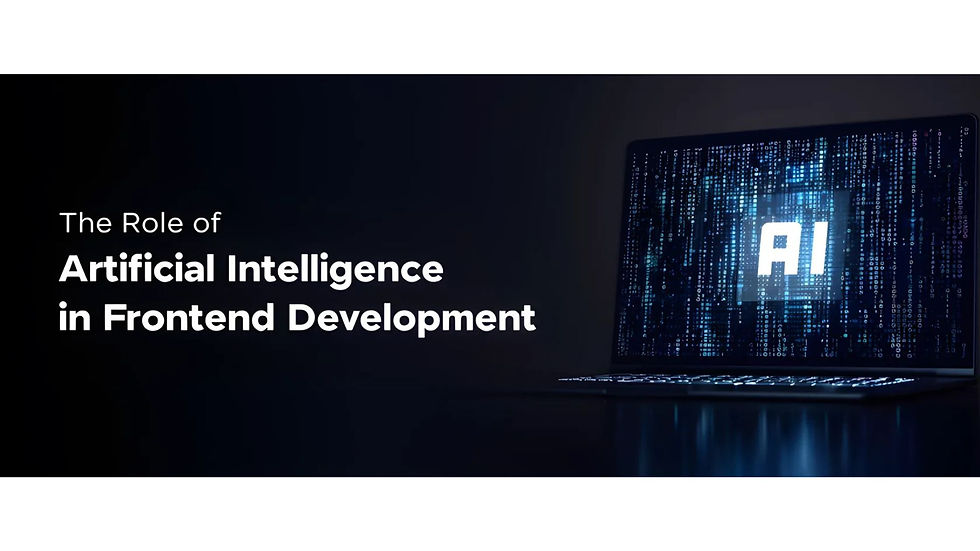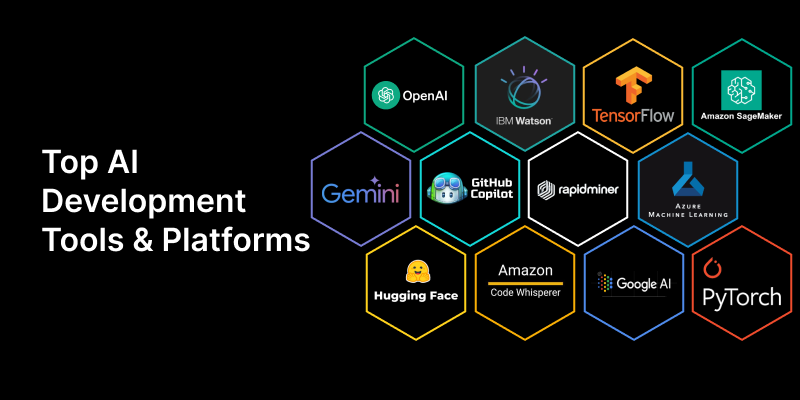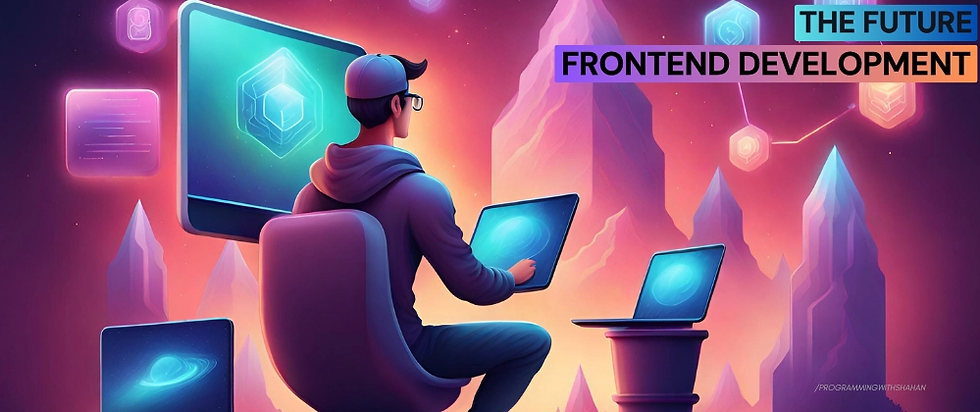AI Assistance In Front-End Development
- Jayant Upadhyaya
- Aug 23
- 8 min read

Artificial Intelligence (AI) is revolutionizing various industries, and front-end development is no exception. With AI's ability to analyze data, predict patterns, and automate processes, it has become an invaluable tool for web developers. This article will explore how AI is being utilized in front-end development, the benefits it brings, and the tools that are making it all possible.
The Role of AI in Web Design
AI is fundamentally changing how web design is approached. Traditionally, web design required manual coding and testing, which could be time-consuming and prone to human error. AI, however, offers new possibilities.
Automating Design Processes
AI can automate many aspects of the design process, significantly enhancing efficiency. For instance, it can generate layout suggestions based on content and user preferences, reducing the time developers spend on trial and error. By analyzing trends and user interactions, AI can propose optimized layouts that align with current design standards. Moreover, AI can optimize design elements like color schemes, typography, and images to enhance user experience. These optimizations ensure that designs are not only aesthetically pleasing but also functional and user-friendly.
Enhancing User Experience
AI-driven tools can analyze user behavior and provide insights that help developers create more intuitive interfaces. By understanding how users interact with a website, developers can make informed decisions about layout adjustments and feature placements. AI can also predict user needs by analyzing their previous interactions, allowing websites to offer personalized content and features proactively. Additionally, AI can simulate user interactions to test design elements, ensuring that the final product meets user expectations before launch.
Streamlining Workflow
AI tools can streamline the workflow in web design by automating repetitive tasks, such as image resizing and content formatting. This automation frees up designers to focus on more creative and complex tasks, improving productivity and innovation. AI can also assist in project management by predicting timelines and resource needs, helping teams to plan more effectively. Furthermore, AI can facilitate communication and collaboration among team members, ensuring that everyone is aligned on the project's goals and progress.
AI Assistance in Front-End Development
In front-end development, AI is not just a trend but a transformative force. It enhances coding efficiency, accuracy, and creativity.
Code Generation and Optimization
AI development tools can generate code snippets, suggest edits, and even write entire sections of code based on predefined parameters. This capability speeds up the development process and ensures code consistency and quality. By learning from existing codebases, AI can propose solutions that align with best practices, reducing the risk of errors. AI can also refactor code to improve performance and scalability, ensuring that applications run smoothly across different platforms.
Debugging and Testing
AI algorithms can identify bugs and suggest fixes, significantly reducing the time developers spend on debugging. Additionally, AI can automate testing processes, providing comprehensive test coverage and ensuring that applications perform optimally across different devices and browsers. By simulating various user scenarios, AI can uncover potential issues that might not be evident during manual testing. Furthermore, AI can track and analyze test results over time, helping developers to identify patterns and prevent recurring issues.
Personalization and Adaptation
AI enables developers to create personalized web experiences. By analyzing user data, AI can dynamically adapt content, layout, and features to meet individual user needs, enhancing engagement and satisfaction. Through machine learning algorithms, AI can learn from user interactions to continuously refine personalization strategies. This adaptability allows websites to remain relevant and engaging, as they can adjust to changes in user preferences and behavior. Additionally, AI can segment users based on their interactions, allowing developers to tailor experiences to different audience groups.
Enhancing Accessibility
AI plays a critical role in enhancing web accessibility, ensuring that websites are usable by people with disabilities. By analyzing content and design elements, AI can suggest improvements to meet accessibility standards, such as adjusting contrast ratios and enabling screen reader compatibility. AI can also automate the creation of alt text for images, making visual content accessible to all users. Furthermore, AI can simulate user experiences for individuals with disabilities, helping developers to identify and address potential barriers before deployment.
Popular AI Development Tools

Several AI-powered tools are making a significant impact on front-end development. Here are a few that stand out:
Adobe Sensei
Adobe Sensei leverages AI and machine learning to enhance design and development processes. It offers features like automated image tagging, smart cropping, and personalized recommendations, making it an essential tool for designers and developers alike. By analyzing user interactions, Adobe Sensei can provide insights into design trends and user preferences, helping teams to create more engaging experiences. Additionally, its integration with Adobe's suite of creative tools ensures seamless workflows for design and development teams.
Fronty
Fronty is an innovative AI tool that converts images into HTML/CSS code. This capability allows developers to quickly transform visual designs into functional web pages, saving time and effort. By automating the conversion process, Fronty reduces the potential for human error and ensures that designs are accurately represented in code. Furthermore, Fronty's AI algorithms can optimize the generated code for performance, ensuring that web pages load quickly and efficiently. This tool is particularly valuable for teams with tight deadlines, as it streamlines the design-to-development transition.
TabNine
TabNine is an AI-powered code completion tool that supports multiple programming languages. It predicts and suggests code snippets as developers type, increasing productivity and reducing the likelihood of errors. By learning from a developer's coding style and preferences, TabNine can provide more relevant suggestions, enhancing the coding experience. Additionally, TabNine's integration with popular code editors ensures a seamless workflow, allowing developers to focus on complex problem-solving rather than routine coding tasks. Its ability to adapt to different programming languages makes it a versatile tool for diverse development environments.
DeepCode
DeepCode is an AI-driven code review platform that analyzes code for vulnerabilities and potential improvements. By leveraging machine learning, DeepCode can detect patterns that indicate security risks or inefficiencies, allowing developers to address issues proactively. Its real-time feedback helps teams to maintain high code quality throughout the development process. DeepCode also provides explanations for its suggestions, enabling developers to learn and improve their coding skills. This tool is particularly beneficial for large teams, as it ensures consistent code standards across multiple contributors.
Uizard
Uizard is an AI-powered design tool that transforms sketches and wireframes into digital designs. By automating the design process, Uizard enables teams to iterate quickly and explore multiple design concepts. Its machine learning algorithms can suggest design improvements based on user feedback, ensuring that the final product meets user expectations. Uizard also facilitates collaboration by allowing team members to share and comment on designs in real-time. This tool is ideal for agile teams that need to adapt quickly to changing project requirements.
Challenges and Considerations
While AI offers numerous benefits, it also presents challenges that developers need to consider.
Data Privacy and Security
AI systems rely on vast amounts of data to function effectively. Ensuring data privacy and security is paramount, as misuse or breaches could have severe consequences. Developers must implement robust security measures to protect user data, such as encryption and secure access controls. Additionally, they should be transparent about data collection practices and obtain user consent before gathering information. Regular audits and updates to security protocols are essential to maintaining data integrity and preventing unauthorized access.
Dependence on AI
Over-reliance on AI tools can lead to a decline in traditional coding skills. Developers should strike a balance between utilizing AI and maintaining their foundational coding abilities. Continuous learning and training are crucial to staying updated with industry trends and emerging technologies. Developers should also engage in manual coding exercises to hone their skills and ensure they remain adaptable to different development environments. Encouraging a culture of innovation and critical thinking can help teams to use AI tools effectively without becoming overly dependent on them.
Cost and Accessibility
Implementing AI technologies can be costly, especially for smaller businesses or independent developers. Additionally, the learning curve associated with AI tools may pose a barrier to entry for some. To address these challenges, developers should assess the cost-benefit ratio of AI tools and prioritize those that offer the most significant impact. Exploring open-source AI solutions can provide cost-effective alternatives without compromising functionality. Providing training and resources can also help teams to overcome the learning curve and fully leverage AI capabilities.
Ethical Considerations
As AI becomes more integrated into web development, ethical considerations must be addressed. Developers should ensure that AI algorithms are unbiased and do not perpetuate discrimination or inequality. Implementing ethical guidelines and conducting regular audits can help teams to identify and mitigate potential ethical issues. Developers should also prioritize transparency in AI systems, allowing users to understand how decisions are made and how their data is used. Engaging with stakeholders and users can provide valuable insights into ethical concerns and foster trust in AI technologies.
Future of AI in Front-End Development

The future of AI in front-end development looks promising. As AI technology continues to evolve, its integration into web development will become more seamless and sophisticated.
Increased Collaboration
AI will facilitate greater collaboration between designers and developers, enabling them to work more efficiently and creatively. By automating routine tasks, AI allows professionals to focus on innovation and problem-solving. AI-powered platforms can also enhance communication and coordination among team members, ensuring that everyone is aligned on project goals. As AI tools become more intuitive, they will bridge the gap between technical and non-technical team members, fostering a collaborative environment that encourages diverse perspectives and ideas.
Smarter User Interfaces
Future AI advancements will lead to smarter, more responsive user interfaces. By leveraging AI's predictive capabilities, websites will be able to anticipate user needs and deliver personalized experiences in real-time. AI can also facilitate adaptive interfaces that adjust to different devices and user preferences, ensuring a consistent experience across platforms. As AI algorithms become more sophisticated, they will enable websites to offer more intuitive navigation and interaction options, enhancing user satisfaction and engagement.
Ethical AI Practices
As AI becomes more prevalent, ethical considerations will play a crucial role in its development and implementation. Developers must ensure that AI technologies are used responsibly and transparently, prioritizing user trust and safety. Establishing industry standards for ethical AI practices can guide developers in creating systems that respect user privacy and autonomy. Engaging with stakeholders and users in the development process can provide valuable insights into ethical concerns and ensure that AI technologies align with societal values and expectations.
AI-Driven Innovation
AI will drive innovation in front-end development by enabling new possibilities and approaches. As AI technologies continue to advance, developers will have access to more powerful tools that can automate complex tasks and generate creative solutions. AI can also facilitate experimentation and prototyping, allowing teams to explore innovative ideas and test their feasibility quickly. By harnessing the potential of AI, developers can push the boundaries of what is possible in web design and create groundbreaking digital experiences.
Conclusion
AI is undeniably transforming front-end development, offering tools and capabilities that were once unimaginable. By automating processes, enhancing user experiences, and improving coding efficiency, AI is empowering developers to create more dynamic and engaging websites.
While challenges exist, the benefits of AI in web design and development far outweigh the drawbacks. By embracing AI tools and staying informed about technological advancements, developers can harness the full potential of AI to drive innovation and deliver exceptional web experiences. As AI continues to evolve, its role in front-end development will only grow, paving the way for more sophisticated and personalized digital interactions. The future of AI in web development is bright, and those who adapt to these changes will be at the forefront of technological progress.






Comments